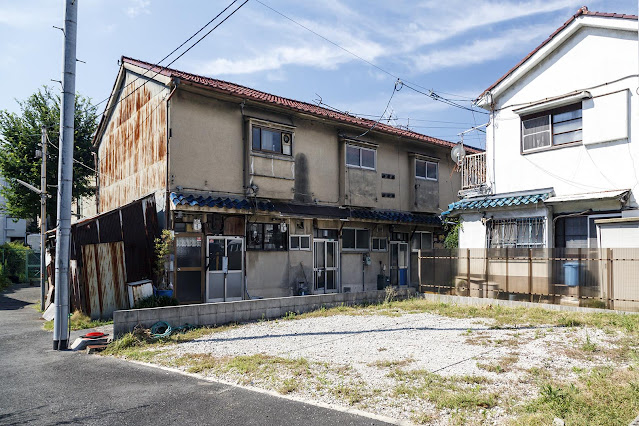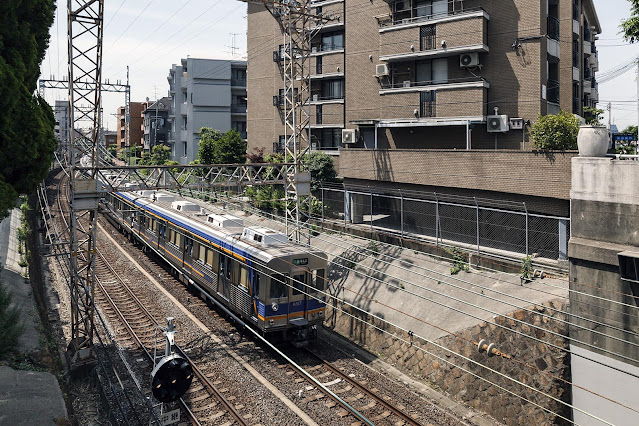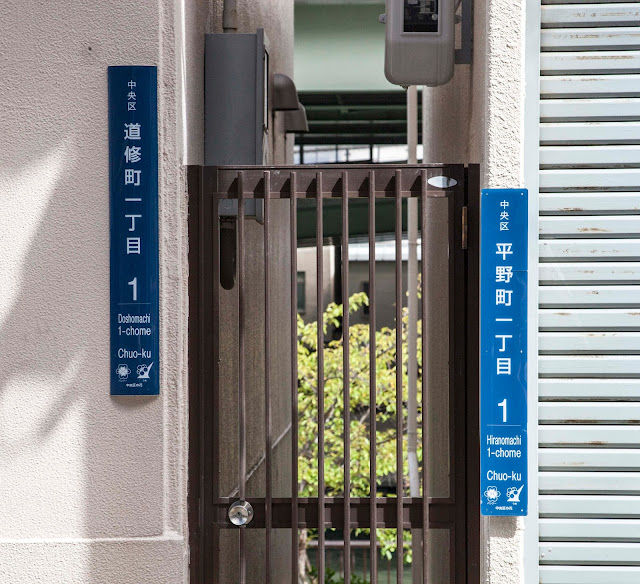TOMATO FOTO HOUSE
写真集「大阪一丁目1番地」
front cover & back cover
Title
/ 書名 :
VIEW
OSAKA Osaka 1-chome
1-banchi / 大阪一丁目1番地
Design
・Edit / デザイン・編集
:
Kinumi
Yabumoto Hiromi
Noda / 藪本絹美 野田紘未
First
Printing :
November
1, 2017 / 2017年11月1日発行
ISBN
978-4-9906907-3-1
Book
Size:
220×286×32mm 329Page
Photo:583
¥7,200+TAX
Sales
and Advertising :
TOMATO
FOTO HOUSE
E-mail
: tomat8kv@gmail.com
©Shiro
Tomatsu 2017
*ご注意*
本書はAMAZONや楽天などのインターネット通販で販売しておりません。
問合せメール:tomat8kv@gmail.com (内藤)までお問合せください。
-----------------------
*店頭販売*
東京都写真美術館2Fミュージアムショップで店頭販売していただいてます。
-----------------------
*店頭販売*
東京都写真美術館2Fミュージアムショップで店頭販売していただいてます。
ショップ名:NADiff BAITEN ナディッフバイテン
大阪城 Osaka-jyo
【英文の後に日本語文があります】
Introduction
|
Osaka 1-chome 1-banchi
Between
around 5000 and 4000 BCE, the topography of Osaka was defined by the
Uemachi Plateau, which extended north to south like a peninsula,
protruding into the sea. And with Kawachi Bay to the east and Osaka
Bay to the west, the area was largely surrounded by ocean.1
Present-day Osaka is built on a sedimentary area formed by soil that
was carried there over the course of a few thousand years by the Yodo
and Yamato Rivers. The city later created new land and towns by
reclaiming various parts of the bay.
In
1496, Rennyo Shonin, a Buddhist priest affiliated with the Jodo
Shinshu sect, constructed Ishiyama Hongan-ji Temple on the site that
would later become Osaka Castle. He also designated Jinai-machi as a
place for merchants and others to live within the temple grounds.
This marked the beginning of Osaka. Since the 16th century, Osaka has
undergone a host of developments and the city’s name is associated
with both the visible and invisible history of the region.
After
the Act on Indication of Residential Address was enacted on May 10,
1962, Osaka was organized according to block names and house numbers
from 1965 and the early ’ 80s.2
Waterways, roads, railways, and other permanent facilities were used
to determine the boundaries of each block, and after unifying
adjacent neighborhoods into wards, historical place names were
replaced with new names. Some 400 names disappeared in the process,
and Osaka is currently made of 24 wards and 581 blocks.3,4
The first addresses (1-1-1 and so forth) were assigned in a
“sequential, meandering style moving clockwise from the area
nearest Osaka Castle.” In other words,
the
numbers were systematically affixed to each location without any
regard for its historical background.5
To
take the photographs in this book, I made actual visits to the 1-1-1
addresses in every block in the city; or when the address was not
clearly defined, I visited the place that correspond to no. 1 in each
block.
How
will the scenery in Osaka change in the centuries to come? It is of
course impossible to know for sure, but I would very much like to see
it. In the same way, I hope that in the distant future local
residents will have a chance to see how Osaka looked in the 2010s.
Tomatsu
Shiro
photographs
shot between Jan. 2015 and Dec. 2016
Notes
1.
The History of Osaka City, Osaka Shishi Hensanjo, ed., Sogensha,
April 1999
2.
“ Organizational Policy for Block Names and Addresses in Osaka City
” ( enacted in 1941; revised in 1965 )
3.
Osaka City Map, Shobunsha, 2015 ( seventh edition, including
supplementary booklet with index of block names and facilities )
4.
The number of blocks represented in this book totals 583, as there
are some areas in the city that are not officially designated as
blocks.
5.
The majority of addresses in Japan are based on block names rather
than street names.
For
the most part, the names are derived from roads and railways that
divide them.
Residential
addresses are also based on a block division and consist of a block
number, street number, and house number.
Whereas,
in the U.S., addresses are primarily determined by street name.
Soemoncho 宗右衛門町
船町 Funamachi
Osaka
1-chome 1-banchi Articles -1
Paper Conservator Tanimura
Hilgeman Hiromi
It
was after his retirement that Tomatsu-san once again went to
university to study photography. His final project was called “
VIEW OSAKA THE DOME ”. In every one of his 75 pictures Kyocera Dome
Osaka is seen.
In
this downtown area where the Dome stands, Tomatsu-san has lived for
50 years with his parents, wife and 3 children. During his
“salary-man” years he says he never really knew his own town, let
alone be engaged with it.
It
was a simple to-ing and fro-ing from home to work, work to home. It
was a revelation, therefore, when he picked up his camera for his
final project and wandering around his town he realised for the first
time how enchanting it was.
How
I met him was through my partner who, like Tomatsu-san, wanders
around town with his camera in hand. He found Tomatsu-san via the
internet. Because of their shared interest in street photography they
started communicating. When I met him, upon introducing myself as a
paper conservator, he may well have wondered what that unfamiliar
sounding job entailed, what I did; that query led me to write this
piece.
In
the mid 1990s when the then media took interest in modern
professional women I was interviewed a few times by newspapers and
magazines. “I am a laundry-woman of paper”, I used to say. The
job is to conserve/repair pictures drawn/printed on paper, but its
main task is literally to wash paper. By washing, the acidity in
paper is washed out which helps prolong the life of paper and hence
preserve the item in question. In reality, I have been working for
museums and galleries conserving their art collections. For
photographic prints, although the substrate used is paper, there
exists a separate genre of conservator, namely, a photographic
conservator.
It
may have been in the 1960s when it was feared that books would not
last more than 20-30 years due to its poor paper quality.
Fortunately, huge improvements have been made since. Photographic
paper quality is normally quite good, but quality paper is key to the
longevity of any art work.
By
the way, this “1-chome, 1-banchi, 1-go (1st district, 1st
sub-quarter, plot no.1)” is the fourth publication of his
photographs. Always using Osaka as his theme, these are his honest,
frontal set of pictures taken while walking in and around Osaka.
There
was the Dome in his first book. Then the rivers in Osaka. The third
focused on the Bunka houses and old-fashioned apartment blocks that
may soon disappear. Tomatsu-san’ s undiluted passion, in trying to
leave as legacy what the real Osaka was like in the early 21st
century, is palpable.
There
must have been many “1-chome, 1-banchi, 1-go” in Osaka. Was he
sure that the pictures he took had that exact address ? Such a
question comes to mind. But then, as you slowly turn the pages you
are no longer bothered; you are soon absorbed by the pictures, and
start to have a warm feeling of actually walking there, feeling the
space.
With
both my parents being from Senba and having been born at 3-chome,
54-banchi in Shin-mori -koji-minami, Asahi-ku, Osaka-city I am an
out-and-out Osaka girl; but even I now feel I want to walk aimlessly
around Osaka.
I
sincerely hope that like me, those of you who take a look at these
photographs would be inspired to take a leisurely walk around Osaka.
With
respect and gratitude to an English-speaking friend for her kind
translation.
堂島地下街 Dojima-chikagai
阿部野橋筋 Abenobashisuji
Osaka
1-chome 1-banchi Articles -2
Paul Hilgeman
Hello,
dear Reader-san,
The
first time I heard the name Osaka was around 1970. A pop group from
Holland, called The Shoes, released a record about a girl named
Osaka. Being barely sixteen at that time, I could hardly imagine that
some decades later I would actually walk the streets of a city with
the same name, Japan's third largest metropolis, Osaka.
In
2004 I visited Japan for the first time. After my arrival at Kansai
international airport I took a limousine bus # 5 to take me to
downtown Osaka. I was to take a train at the Umeda railway station.
Looking out from the limousine initially Osaka looked like a city of
proportions I could easily handle. Not too big and almost like the
towns and cities in Holland I was accustomed to. For instance, in
late 2015 the population of Holland's biggest city, Amsterdam,
numbered 821.702 registered inhabitants. Around the same time the
total of Utrecht's inhabitants, Holland's fourth
largest
city and my hometown, amounted to a mere 339.946.
Therefore
the first fifteen minutes or so I thought my Japanese partner had
largely exaggerated the size of this city. However, coming closer and
closer to my final destination I began to understand that what I had
seen earlier on were only the outskirts. The real Osaka I was about
to enter was almost like stepping into a surrealistic collage of an
imaginary megalopolis. Evidently this city was constructed to
optimize every possible space to the maximum. Often immense bridges
crossing myriads of canals and rivers, highways in every possible
direction, buildings tall as the sky itself; a new world leaving me
totally bedazzled. And that was only what the eye could see. I did
not know anything yet of that vast underground system of layer upon
layer of shops, metro lines, bars and food places, and what not.
O-saka,
literally "big slope", is where my partner was born. Rice
fields and crops, neighbors saying hello, local schools and shops;
she was brought up at the outer edge of the Osaka plain with Ikoma
mountain, separating Osaka from Nara, in full view. Of that world
hardly anything remains. The place has been totally built up.
Still, and depending on your taste of course, this city has much to
offer: great restaurants, shopping arcades, lovely quiet spots amidst
the hectic of big city turmoil, and many other things to discover.
Last
but not least, except for a brief moment in time Osaka never was an
emperor's city. And thus liberated from the burden of responsibility,
less pretentious. It all depends on whom you meet and preference I
suppose, but still, and pardon my generalization, on the whole I find
people from Osaka quite easy going, lighthearted, helpful and
generous. And perhaps a little bit mad also.
Thank
you for reading.
中之島 Nakanoshima
<日本語版>
「大阪一丁目 1
番地」 前書より
紀元前 5000~紀元前
4000頃、大阪市の地形は上町台地が南から北に半島のように海に突き出し、東側が河内湾そして西側が大阪湾で殆どが海でした(注1)。淀川と大和川が数千年という時間をかけて運んだ土砂により形成された堆積地に今の大阪の町があります。更に、大阪市は大阪湾を人工的に埋め立てて新しい土地、新しい町を生み出しています。
1496年、浄土真宗蓮如上人
(れんにょしょうにん
)は後の大坂城となる場所に「石山本願寺」を造営され、寺院境内に商人などが住む「寺内町
(じないまち)」をつくりました。これが「大坂」という町の始まりでした。そし
て、16世紀以降、大坂は大きく発展し大坂の「町名」は地域の由緒・由縁という有形無形の歴史を背負って
受け継がれて来ました。
1962年
5月
10日に施行された「住居表示に関する法律」に基づいて、大阪市は
1965年から
1980年代前半にかけ町名・住居番号の整理を行いました(注2)。町名・住居番号は町名範囲を水路、道路、鉄路そして恒久的な施設等を町界基準とし、区によっては隣接する町を統合し由緒ある町名を新しい町名に変更しました。
消えた町名は 400町余りになり、現在の大阪市は
24区、581町(注3、4
)となりました。
そして、「一丁目
1番地1
号」等の住居番号は「原則、大阪城に近い順に右廻り連続蛇行式」と定め、歴史的背景などを反映しない無機質な番号付けとなりました。(注5)
本書「大阪一丁目
1番地」の撮影は、町名に付与された住居番号「一丁目
1番地 1号」あるいは「1号と思わ
れる場所」を現地確認し、「1号を含む一丁目
1番地」の町内を撮影することとしました。
大阪市の都市景観がこれから百年千年とどの様に変化していくのか、適わぬ事を承知で是非視てみたいと思います。そして、遠い未来の大阪市民に
2010年代の「大阪の町」を視て欲しいと思います。
東 松 至 朗
撮影期間 2015年1月-
2016年12月
注 1
)「大阪市の歴史」 大阪市史編纂所 /編
創元社 1999.4
注 2
)「大阪市町界町名地番整理方針」(昭和
16年制定、同 40年改正
)
注 3
)「都市地図大阪市」 昭文社 2015年第
7版 付属冊子
町名索引・施設索引
注 4
)本書収録町数は 583町です。大阪市には「丁目」のない町も存在します。
注 5
)日本の住所表示の殆どが「街区方式」です。これは、主に道路や線路等に区切られた街区を町名とし、住居番号は
街区を分割して丁目、番地、号と細分化されます。欧米では主に「道路方式」が採用され道路名を住所表示の基準とされます。
新森 Sinnmori
寄稿文-1 谷村
Hilgeman 博美 (紙保存修復家)
東松さんはちゃんとご自分の仕事を勤め上げた後、もう一度大学に入り、写真コースに進まれた。その卒業制作の写真集のタイトルが「VIEW
OSAKA THE DOME」だった。75枚の写真に必ず京セラドーム大阪が写っている。
このドームがある下町に、ご両親、奥さま、そして三人の子供さんと50年住まれた。それでいて、サラリーマン時代は家と職場の往復だけで、ほとんど自分の町のことを知らず、
それについての意識もなければ、かかわりも持たずにいたとおっしゃる。卒業制作にあたって、カメラを手に下町を徘徊して、初めてこの下町の魅力に気付いたと。
東松さんにお目にかかったのは、やはりカメラを手に街を徘徊する私のパートナーを通じてで、彼はインターネットで東松さんを見つけた。二人ともストリート・フォトグラファーであることからお付き合いが始まった。
東松さんは、大阪で初めてお目にかかった時すでに、わたしの聞き慣れない職業について、いったい何をしている人だろうと思われたのかもしれない。この疑問が、今回この文章を書かせていただくきっかけになった。
90年代の半ば、女性の職業が注目されていたころ、何度か新聞や雑誌のインタヴュ―を受けた。「紙の洗濯屋です。」と言ったものだ。紙に描いてある絵の修復をするのだが、文字通り紙を洗うことが作業の中心だ。それによって紙の中の酸性物質が洗い流され紙は長生きすることになるので、紙の保存にも寄与する。現実的には、美術館、画廊さんの作品の保存修復にかかわってきた。写真については、紙が支持体という意味で同じ分野ではあるが、写真の修復家が存在する。1960年代だったか、本が全て20
~30年でだめになると騒がれた時があった。以降、紙の質はどんどん良くなった。写真プリント用の紙は、普通、非常に質がいいのだが、質の良い紙を選ぶことが、
作品の長生きの基本である。
ところで、東松さんの写真集は、今回の「大阪一
丁目 1
番地」で4冊目になる。常に大阪がテーマで、大阪を小まめに足で歩いて撮った、嘘のない、真正面から撮る対象に対峙した写真群である。1冊目にはドームがあった。2冊目は大阪の川。3冊目はだんだん姿を消してゆく文化住宅
やアパート。そこには21世紀初頭のあるがままの大阪の姿を後世の人々に伝えたいという、東松さんの真摯な熱意がある。
今回の一丁目 1番地
1号は、大阪中でずいぶんな数になると思われる。さらに、一体どの家が、またどの場所が
1番地
1号なのか判断のつかない場合も多かったのではなかろうか。写真を見ても、まさにそのままの疑問をいだいてしまう。が、もう少し余裕を持ってページ
をめくっていると、もう 1
番地 1号が気にならなくなる。一枚一枚の写真が、通りがかりの
何気ない風景になっていく。誰もが気軽に入っていける、そこを歩いているような気になる温かみのある空間である。両親共に船場の出で、大阪市旭区新森小路南
三丁目54番地 (新称
:新森
)に生まれた生粋の大阪っ子のわたしだが、いつかゆっくり目的なしに大阪を歩いてみたい気持ちになる。
この写真集を手にされる方々も、わたしと同じようにゆっくり大阪を散策していただきたいと心から思っている。
難波
Nanba
寄稿文-2 ポール・ヒルヘマン
(写真家)
読者のみなさん、こんにちは。
僕が最初に大阪という名前を聞いたのは1970年ごろでした。オランダのシューズという名のポップグループが、オーサカという名の女のコについてのレコードを出したのです。当時、僕は16歳になったばかりでしたが、何十年か後に本当に僕がその歌と同じ名前の都市を歩くなんて、日本第3番目の大都市、
大阪に行くなんて考えてもみませんでした。
2004年、僕は初めて日本に行きました。関西国際空港に着いて、大阪市街に行く5番のリムジンバスに乗りました。
僕は梅田駅から電車に乗ることになっていました。最初、リムジンバスから外を眺めていた時は、気楽にやっていけそうな大きさの都市に見えました。大き過ぎず、僕が慣れているオランダのあちこちの町や都市程度に。たとえばオランダの一番大きな都市、アムステルダムの2015年末の人口は821,
702人です。オランダの4番目に大きな都市ユトレヒト、そこに僕は住んでいるのですが、その人口は339,946人。
ですから、最初の15分間ほどは、僕の日本人のパートナーはこの都市の大きさについてずいぶん大げさなことを言ったものだと思っていたのです。けれど、だんだんと目的地に近づくにつれて、先に見たものは街の周辺部に過ぎなかったということが分かってきました。今、自分が入ろうとしている現実の大阪は、シュールレアリストが想像するメトロポリスのコラージュの中にでも入って行くようでした。この都市は、
まさに一つ一つのスペースを可能な限り最大限に活用して建設されていました。巨大な橋がたくさんの川や運河を交錯し、ハイウェイはあらゆる方向に延び、ビルディングは空と同じ高さ、僕はこの新しい世界に頭がくらくらしました。が、それは単に目に見えているものの話だったのです。
その時、僕はまだ、いろんな店、地下鉄、レストラン、バーやなんかが詰まって何層にも重なった恐ろしく広い地下の世界を知らなかったのです。
オーサカ、大きな坂という意味だそうですが、僕のパートナーはそこで生まれました。田んぼや畑、お互いに挨拶しあう近所の人たち、土地の学校や商店、大阪と奈良を隔てる生駒山を見渡す大阪平野の端で彼女は育ちました。そんな世界はもう、ほとんど何も残っていません。すべて建物や道で埋め尽くされてしまいました。それでも、もちろんあなたの感覚によるのですが、この都市は沢山のものを提供してくれます。素晴らしいレストラン、商店街、忙しい大都市の喧噪の中の可愛い静かな一画など、多くの発見があります。
最後に、大阪は、歴史上、ほんの短い期間を除いて、天皇陛下の都市だったことがありません。そのせいでいわゆる責任感の重みから解放されているというか、気取りがありません。あなたの出遭う人や好みによるでしょうが、それに僕の一般的な言い方を許してもらえるなら、大阪の人たちは大抵、気軽で、屈託がなく、気持ちが広くて、困った時は助けてくれる人たちというのが、僕の印象です。それに、ちょっとクレイジーかもしれません。
読んでいただいて、ありがとうございました。
www.phaudio.nl<オランダ ユトレヒト市在住>
新喜多東 shigita-higashi
<補足>
東松至朗写真集「大阪一丁目1番地」 解題
NHKラジオドラマの「一丁目1番地」
昭和30年代、NHKラジオ子供番組に「一丁目1番地」というラジオドラマがありました。月曜日から金曜日まで、夕方6時半ごろから15分のホームドラマです。ドラマは東京都内のある住宅街の「1丁目1番地」が舞台でした。二つの家族のなんでもない日常物語で、ひと月毎にメインの家庭を変えていました。本格的な岐阜の田舎に生まれた私にとって、家にテレビも無い時代だったので、ラジオから流れる「一丁目1番地」は大都会東京の都市生活を窺い知る数少ない機会でした。そして「一丁目1番地」は訪ねることも適わぬ遠い遠い憧れの街でもありました。
政党の「一丁目1番地」
20世紀の終り頃から、国政選挙となるとよく耳にするのが「わが党の政策の一丁目1番地は・・・」という言葉です。政治の世界で「一丁目1番地」
とは何か? 辞書は「最初に実施すべき最重要な事柄をたとえていう。最優先課題」と書いてあります。政党が最優先に実施すべき目玉政策をたとえていう言葉です。政治の世界では「一丁目1番地」の政策が政党にとって特別な意味を持つ重要なキーワードのようです。
因みに、政治の中心地である永田町の「一丁目1番地1号」は国会議事堂前の憲政会館になります。
大阪の「一丁目1番地」
拙著『大阪一丁目1番地』は大阪市内に現存する全町の「一丁目1番地」の写真集です。なかには「丁」を持たない小さな町も有りますが。
50年前、大阪に移住した時から、大阪市の「一丁目1番地」は夫々の町を代表する場所で、他の丁目番地と違う特別な土地であると思い込んでいました。が、意外にも、大阪の「一丁目1番地」は単にその町区画の中で一番大阪城に近い場所という意味でした。「一丁目1番地」は偶々、偶然に「一丁目1番地」だったという意味合いで、単なる連番符号以外の意味は有りません。「一丁目1番地」が政治の世界と現実の世界と意味合いが大きく乖離しているのは、何か深い思い込みや思惑が有るのでしょうか?
『大阪一丁目1番地』は、恐らく誰も憧れも興味も持たない「一丁目1番地」の写真を集めれば、それはそれで何気ない大阪風景集になり、2015~2016年の大阪市記録になるのではと思っています。
海岸通 Kaigandori
**************************
**************************


















































